- Details
- Hits: 14701
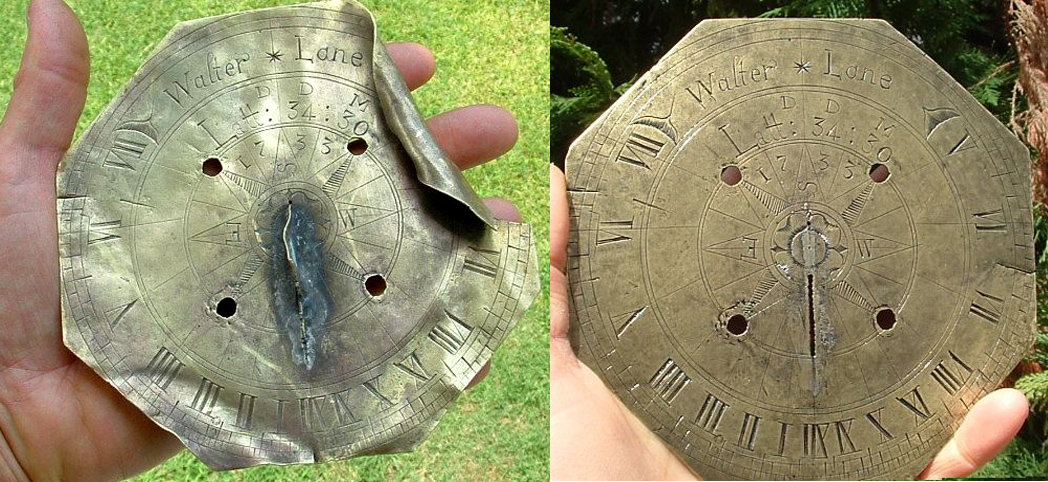 It started simply enough. Keith, a "treasure hunter" reported finding a 1733 sundial "in the Carolinas". (http://www.treasurenet.com/forums/my-best-finds/603181-1733-colonial-sundial-found-restored.html). The brass sundial about 5 or 6 inches in size was found crumpled and apparently had a number of modern attempts to solder a gnomon back onto the dial plate. Kieth reported, "When I found the piece it had been bent and damaged so I sent it to an expert in restoring metal objects....It has been the best find of my relic hunting career. I hope to get some detailed info from people who know about sundials."
It started simply enough. Keith, a "treasure hunter" reported finding a 1733 sundial "in the Carolinas". (http://www.treasurenet.com/forums/my-best-finds/603181-1733-colonial-sundial-found-restored.html). The brass sundial about 5 or 6 inches in size was found crumpled and apparently had a number of modern attempts to solder a gnomon back onto the dial plate. Kieth reported, "When I found the piece it had been bent and damaged so I sent it to an expert in restoring metal objects....It has been the best find of my relic hunting career. I hope to get some detailed info from people who know about sundials."
The dial is done in the English style of the period, that is to say, the dial is cut as an octogon with a circular chapter ring with Roman numerals and delineated on the outside to the quarter hour. In the center is an 8-point compass rose with the cardinal points labelled "N,S,E,W". Four crude and somewhat modern screw holes held the dial to some modern base. The maker's initials D.D.M. are berlow the engraving of the original owner "Walter * Lane" with the date 1733.
As Kieth notes, "[The dial] is one of the earliest from southern colonial America". But the problem is where? The engraved latitude is "Latt: 34:30". Using Serle's ruler confirms that the delineated hour lines are between 34 and 35 degrees. That should allow a quick check of southern cities to identify the home of this dial. The center of population in the 1750's was Willmington, NC at 34:14. If we assume that William Lane was a farmer a person of means, then two possibilities arise: Blenheim SC and Laurens SC both at 34:30. Laurens County, in particular, was in the area where thousands of immigrants, mainly Scottish and Irish, settled in the pre-revolution Carolinas. Then there is Kershaw SC at 34:32 which was settled around 1732 by English traders and farmers who moved inland from Charleston. What was the provinance of this dial? We may never know, but you can search the below 1755 map from University of North Carolina library of historic maps for towns and river portsat: https://dc.lib.unc.edu/cdm/ref/collection/ncmaps/id/123
NEW INFORMATION:
A descendent of Walter Lane sent the following: Walter Lane lived in New Bern, Craven County, North Carolina. Apparently he left Maryland in the 1720's and by 1726 showed up in records of Craven County. In 1729 he was listed as a Commisioner of New Bern, and probably a person of means. The sundial could very possibly be his. Looking at the map below, New Bern is just north of latitude 35 degrees on the mouth of the Neus [Neuse] river. If we accept the latitude of the dial as 34:30, Walter lived about 35 miles south of New Bern, perhaps on a farm near Wilmington, S.C. Old records show that much of South Carolina in 1734 was considered Craven County.
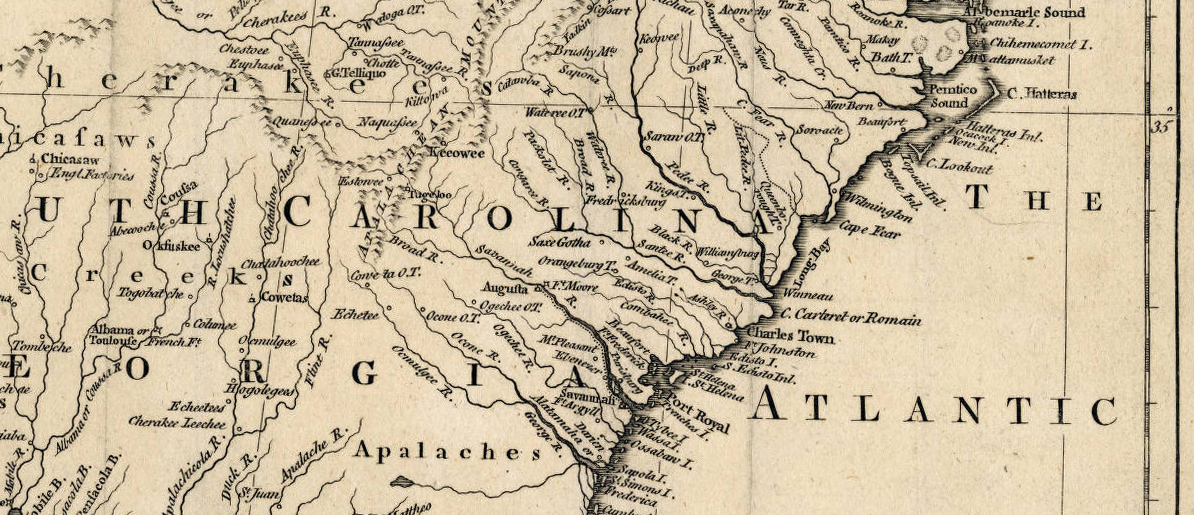
- Details
- Hits: 13984
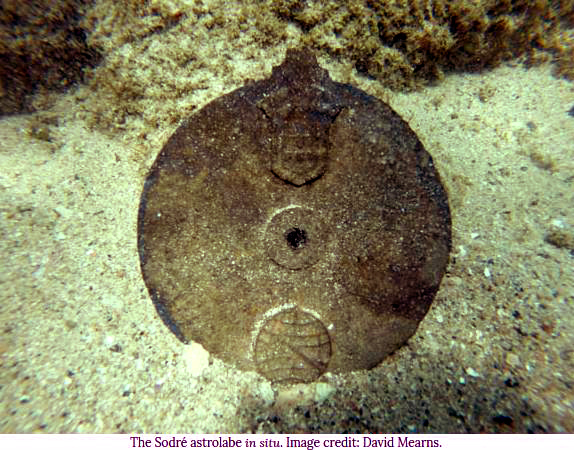 A team led by David Mearns reported on the oldest Mariner's Astrolabe in a recent article of the International Journal of Nautical Archaeology. During a 2013-2014 series of diving expeditions off the coast of Oman they discovered a Portugues solid leaded-gunmetal disk astrolabe. As the authors put it, "A well-documented and dramatic story from one of the earliest Portuguese foyages to India ... involves the loss off two naus [sailing vessels], the Esmeralda and Sao Pedro, which sank in shallow waters off the coase of a remote Omani Island in the Arabian Sea." What has made this legend is that these ships were part of a Portuguese armada to India led by the legendary explorer Vasco da Gama. Mearns tells the story that following the return of da Gamma and the main fleet to Portugal in February 1503, Vicente and Bras Sodre, uncles of da Gama, led their two ships back to patrol the waters off the south-west Indian coast. But Vicente sailed his squadron to the Gulf of Aden where they looted and burnt a handful of Arab ships. "Vicente then took his ships to Al Hallaniyah ...where they found a safe anchorage to shelter from the south-west monsoon...It was in this location, in May 1503, where a sudden and furious wind tore the two naus from their moorings and drove them against the rocky shoreline smashing their wooden hulls and causing the deaths of many crew, including the squadron commander Vcente Sodre"
A team led by David Mearns reported on the oldest Mariner's Astrolabe in a recent article of the International Journal of Nautical Archaeology. During a 2013-2014 series of diving expeditions off the coast of Oman they discovered a Portugues solid leaded-gunmetal disk astrolabe. As the authors put it, "A well-documented and dramatic story from one of the earliest Portuguese foyages to India ... involves the loss off two naus [sailing vessels], the Esmeralda and Sao Pedro, which sank in shallow waters off the coase of a remote Omani Island in the Arabian Sea." What has made this legend is that these ships were part of a Portuguese armada to India led by the legendary explorer Vasco da Gama. Mearns tells the story that following the return of da Gamma and the main fleet to Portugal in February 1503, Vicente and Bras Sodre, uncles of da Gama, led their two ships back to patrol the waters off the south-west Indian coast. But Vicente sailed his squadron to the Gulf of Aden where they looted and burnt a handful of Arab ships. "Vicente then took his ships to Al Hallaniyah ...where they found a safe anchorage to shelter from the south-west monsoon...It was in this location, in May 1503, where a sudden and furious wind tore the two naus from their moorings and drove them against the rocky shoreline smashing their wooden hulls and causing the deaths of many crew, including the squadron commander Vcente Sodre"
Recovered from the ocean after 500 years was the 17.5 cm 344 gram metal Sodre astrolabe as well as more than 2000 other metal and ceramic artifacts. The were slowly desalinated over a period of two years. The astrolabe was clearly decorated with the Portuguese royal coat of arms at top and an esfera armilar (armillary sphere) at bottom. But there was no alidade or any visible gradations. Using laser imagery a total of 18 scale marks became visible along the limb of the upper right quadrant with a spacing of 5 degrees. These marks probably extended to make a full 90 degree quadrant. The solid metal Sodre astrolabe is a rarity, for shortly after 1500 a new generation of open ring astrolabes emerged. An illustration of a mariner's astrolabe from the Boria Chart (1529) shows a ring planisphere with angles marked for 180 degrees. The new open design remaind stable in the wind and became the dominant navigation instrument for the next 170 years. Read the full article at https://onlinelibrary.wiley.com/doi/epdf/10.1111/1095-9270.12353 or a short condensed version at World’s Oldest Mariner’s Astrolabe Found | Archaeology | Sci-News.com
- Details
- Hits: 14260
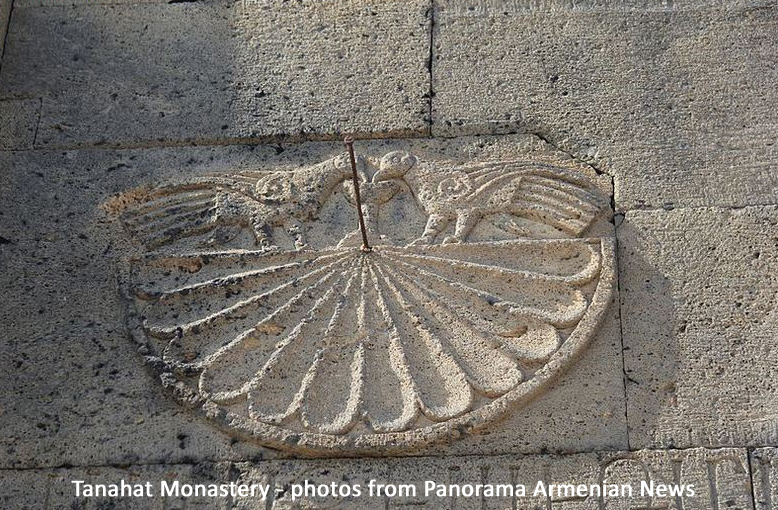 Last February in the Panorama Armenian News an article reviewed some of the oldest sundials in Armenia. Piliposyan, Doctor of History at the Preservations Service for Historic-Cultural Reserve-Museums and Historic Environment (SNCOT) related that the oldest sundial may be on the Zvartnots temple dating to the 7th century. Sundials have been preserved on buildings of Dsegh, Tsakhkadzor, Dilijan, Noyemberyan as well as Nagorno Karabakh churches. Sundial also were curved on khachkars [Armenian cross-stones]. In the Panorama article Piliposyan said that apart from serving as clocks, sundials served as a means of communicating with god. He brought the example of the Zvartnots temple sundial found during excavations with enclosed documents calling on prayers to talk to god whatever time it was.
Last February in the Panorama Armenian News an article reviewed some of the oldest sundials in Armenia. Piliposyan, Doctor of History at the Preservations Service for Historic-Cultural Reserve-Museums and Historic Environment (SNCOT) related that the oldest sundial may be on the Zvartnots temple dating to the 7th century. Sundials have been preserved on buildings of Dsegh, Tsakhkadzor, Dilijan, Noyemberyan as well as Nagorno Karabakh churches. Sundial also were curved on khachkars [Armenian cross-stones]. In the Panorama article Piliposyan said that apart from serving as clocks, sundials served as a means of communicating with god. He brought the example of the Zvartnots temple sundial found during excavations with enclosed documents calling on prayers to talk to god whatever time it was.
The vertical dials had horizontal gnomons and on the dial face there are typically 12 equally spaced divisions to mark the hours. Frank King commented on the dials that "These are variants of the standard European sundials used for indicating 'unequal [temporal] hours', at least approximately, in medieval times. Several thousand survive in England alone. They divide the daylight period from sunrise to sunset into 12 parts. Unfortunately, these parts are not equal in time and their relationship varies with the time of year....The examples in the photographs seem very nicely made."
To appreciate the Medieval Armenian dials as well as modern interpretations, visit https://www.panorama.am/en/news/2019/02/23/Armenian-sundials/2076856
- Details
- Hits: 12462
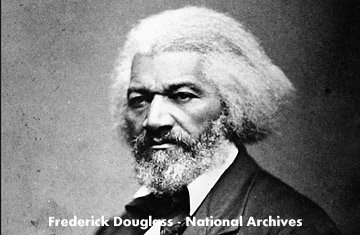 The Frederick Douglass home, also know as Cedar Hill, is located at 1411 W Street, SE in Anacostia. After Douglass' death in 1895, his widow Helen Pitts Douglass (a suffragist and abolitionist) founded the Frederick Douglass Memorial and Historical Association in 1900. In 1916, the National Association of Colored Women's Clubs joined with the association and jointly owned the house until 1962.
The Frederick Douglass home, also know as Cedar Hill, is located at 1411 W Street, SE in Anacostia. After Douglass' death in 1895, his widow Helen Pitts Douglass (a suffragist and abolitionist) founded the Frederick Douglass Memorial and Historical Association in 1900. In 1916, the National Association of Colored Women's Clubs joined with the association and jointly owned the house until 1962.
One of the Colored Women's Clubs, the Married Women's Culture Club of Pittsburgh, contributed a sundial to the Douglass House in 1922 when it was opened as a national museum. The sundial contains a challenging motto: "My face marks the sunny hours. What can you say of yours?"
According to an article in the Pittsburgh Post Gazette by Mark Holan (http://www.post-gazette.com/opinion/Op-Ed/2018/07/22/Marking-time-with-Frederick-Douglass/stories/201807220003) "The reasons that the Married Women’s Culture Club chose a sundial to donate to Cedar Hill are unknown. Having 'secured the dial and prior to sending it east for installation at the grounds,' the club held a July 9, 1922, dedication ceremony at Pittsburgh’s Euclid Avenue A.M.E. Church,' according to The Pittsburgh Press.... Just three Augusts after the Cedar Hill ceremony, more than 30,000 members of the Ku Klux Klan paraded down Pennsylvania Avenue. Even in the darkest of times, however, the Pittsburgh women’s gift of that sundial at Cedar Hill has marked the sunny hours."
You can read more about the history of the Douglass House and see a photo of the 1922 sundial at http://allenbrowne.blogspot.com/2012/09/cedar-hill.html The photo taken by Allen Browne shows the dial has survived the years well, except that someone has reinstalled the gnomon backwards.
- Details
- Hits: 11924
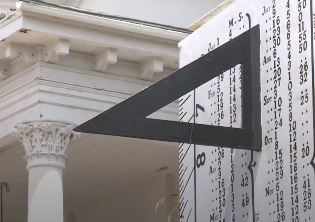 In this age of smartphones and digital wrist watches, the Barnwell Sundial in front of the Court House in Barnwell, South Carolina continues to tell accurate time. As reported by the television stations WRDW and WAGT, "It was put up in 1858 after it was given to the county by state senator Joseph D. Allen. The sundial keeps very accurate standard time, even though that wasn't established until 1884. [Telling standard time is possible through Equation of Time corrections listed on the face of the dial.] The courthouse that is located near it burnt down in 1865, but the sundial stood tall. In 1918, still in it's original location, a concrete curbing was built around the sundial to protect it from traffic. Over the years, it was restored and fixed up."
In this age of smartphones and digital wrist watches, the Barnwell Sundial in front of the Court House in Barnwell, South Carolina continues to tell accurate time. As reported by the television stations WRDW and WAGT, "It was put up in 1858 after it was given to the county by state senator Joseph D. Allen. The sundial keeps very accurate standard time, even though that wasn't established until 1884. [Telling standard time is possible through Equation of Time corrections listed on the face of the dial.] The courthouse that is located near it burnt down in 1865, but the sundial stood tall. In 1918, still in it's original location, a concrete curbing was built around the sundial to protect it from traffic. Over the years, it was restored and fixed up."
See the video of Phill Huggins tell about how he got the opportunity to restore the sundial.
http://www.wrdw.com/content/news/Unique-Barnwell-sundial-stands-the-test-of-time-484160371.html
- Details
- Hits: 14136
 With the Masters Tournament playing in Augusta and the return of Tiger Woods, many golf enthusiasts think back to other great players. One of the greatest was Bobby Jones. John Steinbreder writes about a sundial in his honor, "Another reminder of Jones here [at the Augusta National Golf Club] is a small bronze statue just 18 1/2 inches in height that is part of a working sundial outside the Member Golf Shop and just across from the first tee. The effigy boasts a rich, brown patina and etched across the lower part of the sundial are the words: 'Slow Back, Time Right.'
With the Masters Tournament playing in Augusta and the return of Tiger Woods, many golf enthusiasts think back to other great players. One of the greatest was Bobby Jones. John Steinbreder writes about a sundial in his honor, "Another reminder of Jones here [at the Augusta National Golf Club] is a small bronze statue just 18 1/2 inches in height that is part of a working sundial outside the Member Golf Shop and just across from the first tee. The effigy boasts a rich, brown patina and etched across the lower part of the sundial are the words: 'Slow Back, Time Right.'
Back in the 60's Pete Pascale found the statue and dial in a scrap metal dumping ground in Erie, Pensylvannia. After cleaning and repairing the statue, he gave it to Rick and Hank DeDionisio who ran Ricardo's Restaurant in Erie. The brothers were avid golfers and in turn presented the figure and dial to their Downing Golf Club. As Steinbreder writes,"...the brothers and club hit upon the idea of offering the statue to Augusta National, because of their admiration of Jones. They asked John May, a senior editor at Golf Digest, to act as an intermediary, and the journalist contacted Roberts in a letter dated May 18, 1972. Some time later, the Sundial took its place outside the Member Golf Shop."
Read about August National and the Sundial at: http://www.goerie.com/sports/20180406/erie-residents-helped-iconic-sundial-reach-augusta-national
It is believed that Edwin E. Codman, the English artist crafted the piece in the 1930s, using Jones as the model for the figure. Codman spent the early part of his life in England working at the Gorham foundry, creating small exquisite bronze sculptures. In 1931 he moved to Dorset, Vermont where he and his wife lived quietly until his death in 1955. Looking at history, Bobby Jones won fame between 1923 to 1930, culminating with the Grand Slam that included the British Amateur and British Open. It is very plausible that Codman made the sculpture and sundial in 1930 to recognize the fame of this retiring golfer.
The real story behind the Bobby Jones sundial is ultimately instructive for the world of golf: In Augusta, it doesn't tell correct time, even solar time. If Codman made the sundial in the UK, it explains the angle of the golf club shaft, closer to the latitude angle of London at 51 degrees rather than 42 (Erie, PA) and certainly not 36 degrees (Augusta, GA). This may be confirmed by the face of the dial, where the hours span from 4am to 8pm, allowing for the variation of sunlight in England, not Georgia.
So the joke is on all those golfers who look to the Bobby Jones sundial, as the only time telling device on the course: it has never told correct time (except for noon) in Augusta and never will. It would be fun to get a rubbing of the dial face to prove it runs on London time.
- Details
- Hits: 9564
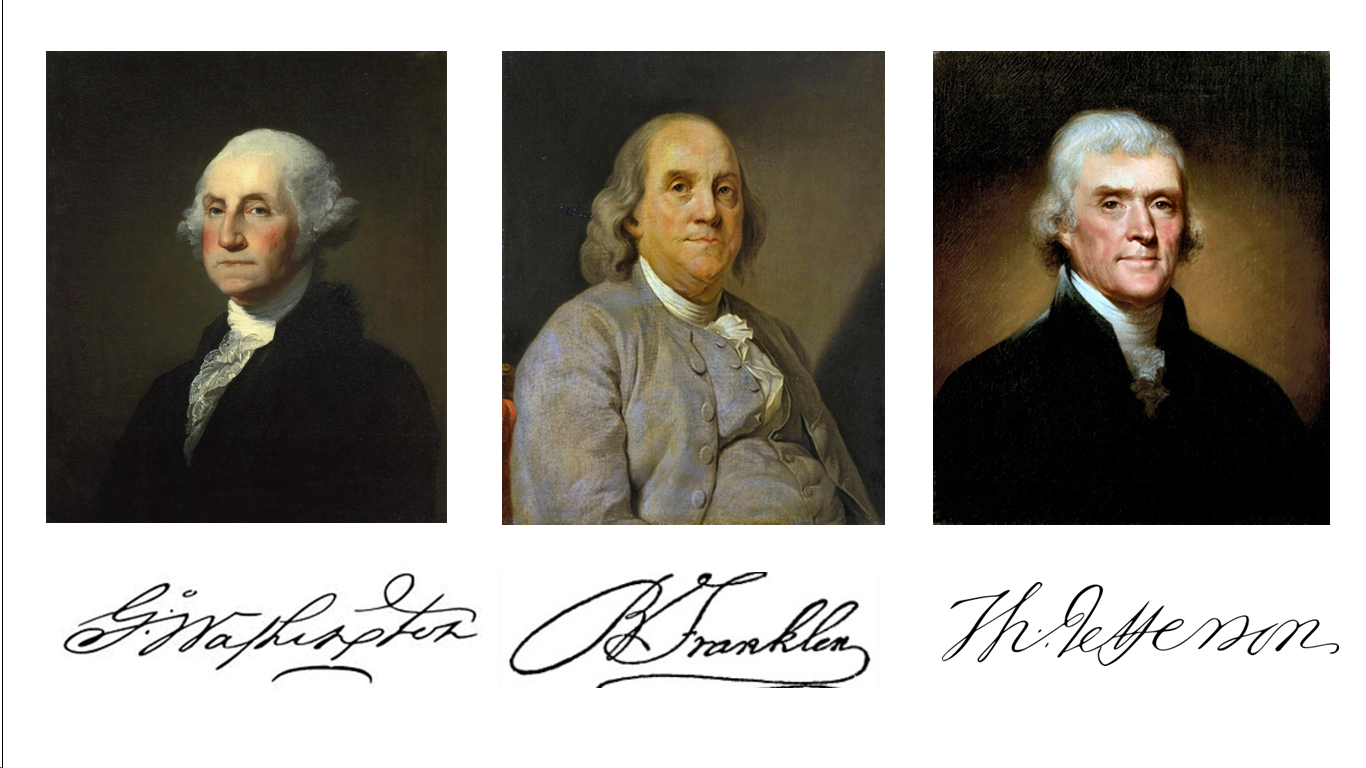
Did you know that Thomas Jefferson designed sundials and thought that a book of trigonometric tables was one of his most valuable books? And that Benjamin Franklin made a "modest" proposal for an extension of the noon-day sundial canon? Join Fred Sawyer, eminent sundialist and president of the North American Sundial Society as he explores sundial history with the United States founding fathers George Washington, Benjamin Franklin and Thomas Jefferson in three video presentations. The videos are taken from a presentation he made two years ago at the annual meeting of the NASS in Indianapolis. See these videos at: http://www.sundials.org/index.php/dial-links/videos/historic-sundials
Learn more about sundials, their construction and their history by joining the North American Sundial Society. Go to http://www.sundials.org/index.php/join-nass/join-nass and join now.
- Details
- Hits: 13239
In 2000 the North American Sundial Society held its annual conference in San Francisco and visited the Ingleside Terraces Sundial. A century ago the site was a racetrack and as it turned into a housing development in 1913, a promotion sundial was installed with the advertisement "largest sundial in the world". Michael Callahan of "This Forgotten Day in San Francisco" talks about this historic dial and the developer Joseph A. Leonard of Urban Reality Improvement Company on November 15, 1913.
- Details
- Hits: 13123
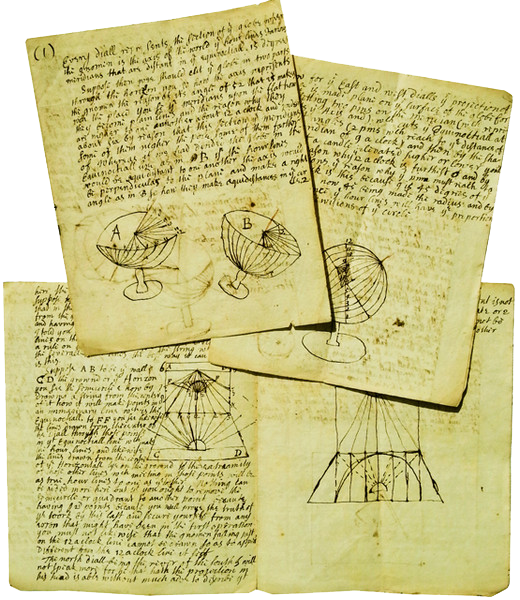
|
In 1636 or 1637 Samuel Foster, a distinguished Professor of astronomy at Gresham College produced a manuscript that describes the construction and use of an analemmatic sundial, a vertical sundial, and a declining sundial.
The collection of 12 pages on four double leafs each measure 15 x 18 cm. This manuscript relates to Samuel Foster's most important invention, a computational device known as a dialling scale, and precedes the publication of his second and most significant book in 1638 "The Art of Dialling: by a New, Easie, and Most Speedy Way ..."
